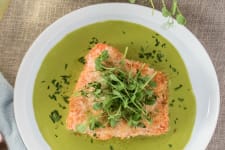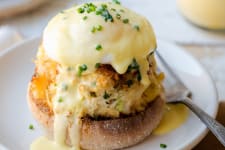
A Wild Salmon Life With Melanie Brown
October 10th, 2024How a Summer of Fishing Leads Into a Fall of Gatherings
When Bristol Bay fisherman and Kallenberg family friend Melanie Brown isn’t fishing, she’s focused on advocating for wild salmon, lending her voice and experience toward ensuring the continuance of wild salmon as a source of sustenance.
As an Alaska Native, Melanie sometimes takes on the role of community leader and Elder in training. For nearly a decade, she’s led an annual fish cutting workshop at the Elders and Youth Conference in Anchorage, demonstrating how to cut fish with an ulu, a blade that, as Melanie explained, is “a crescent-shaped knife traditionally used by women of various Indigenous arctic and subarctic peoples, such as the Inuit, to prepare fish.” Sharing her knowledge with the Indigenous community through these workshops is a way to ensure that these foundational traditions are practiced actively today, and far into future generations of Alaska Natives.
This year’s Elders and Youth Conference convenes next week, so in anticipation of the gathering, Melanie has shared an essay about what this busy meeting season is like for her. As always, we’re thrilled to share Melanie’s writing with you, and hope it’s something that can help you to observe Indigenous Peoples’ Day this coming Monday.
***
A Wild Salmon Life
By Melanie Brown
The fall time is often referred to as meeting season, and in Alaska it really starts to build up when people are transitioning away from fishing, gathering and hunting. Once the food has been preserved and put away for the winter, people are ready to come together and move into more cerebral states of being.
The fall meeting season includes annual gatherings that focus on Alaska seafood marketing and other industry concerns — conferences where I’m able to network, lend my voice to regulatory matters, and share information and experiences with other people whose lives are connected to wild salmon.
There is a very special week that Indigenous people of Alaska refer to as Native New Year. It is a week that begins on a Sunday afternoon with First Alaskans Institute’s annual Elders and Youth Conference and ends on the following Saturday night with a banquet that concludes the Alaska Federation of Natives annual convention. Indigenous people come from all over the state to be delegates for their regions. Information is exchanged, knowledge is shared, and goods are traded or sold — including regalia and native foods.
Each year I put in a proposal to lead a fish cutting activity with my friend Gayla during the Elders and Youth portion of the week. This year will be the 8th year in a row that we have led a session, and we hope to keep doing it until we are too old to do it anymore. If it were not for the former director of First Alaskans Institute encouraging me to submit a proposal, I would not have ever dreamed of leading a fish cutting workshop because I don’t consider myself an expert like the ulu wielding women who cut fish after fish at the cutting table to have food for the winter.

This encouragement helped me to realize that many other people likely feel inadequate about their fish cutting skills like I do. Fishing during the salmon run does not give me a lot of time to practice my fish cutting, but I am able to cut a fish well enough to make food with it. Each time I cut a fish my skills improve.
For youth who attend the Elders and Youth Conference, I would like to think that our Living and Loving Our Cultures workshop is a chance to give them just enough experience that they will feel the confidence to seek more opportunities to handle fish and participate in the culture that has sustained our people since we first started interacting with salmon. This is especially important for youth who now live in urban areas and may feel separated from their people and home villages.

My work is guided by where people come together to talk about salmon, and I get to see salmon matters from many perspectives. In my experience I find that when people who talk about salmon get to eat salmon together, it seems to heighten the focus of why people came together to begin with. Eating and feasting together makes the invisible fabric of a community visible through the physicality of the food. When meetings get long, and the words get tiresome, breaking bread together can bring clarity around what is foundational in our lives and underscore that we need food to live. Leading the fish cutting time with Gayla is wonderful because the act of cutting salmon to make food with the people who are there is a way of speaking about our love of salmon and the work we do to protect them, without leading with an agenda.
Instead, we get to lead with our hearts and hands.
***
Before I sign off today, I am excited to share that for the second year in a row, Wild Alaskan Company has been nominated by USA TODAY for their 10 Best Readers’ Choice Awards for Best Meat Delivery Service. Please vote to show your appreciation for wild-caught, sustainable seafood from Alaska — not just for the seafood, but for the community that you’ve helped us sustain over the years. You can vote once per day through October 28 using the link here.
Live Wild,
Monica
Pictured above: A snapshot from the cutting table at last year’s Elders and Youth Conference, with Deb, Melanie (center), and Gayla cutting a fillet in preparation for pickling. Photo credit: SalmonState





